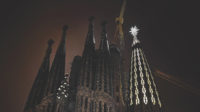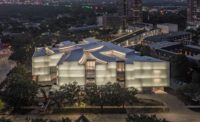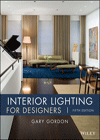Montreal
The Great Light Way
In January 2005, the Quartier des Spectacles Partnership of Montreal, an organization of area stakeholders dedicated to promoting Montreal’s cultural district, took on an ambitious urban-branding project: creating a cohesive identity for the 20 cultural venues and two public squares that make up the area. With art direction by branding experts Ruedi Baur and Jean Beaudoin, of Integral, the solution is a stunning architectural light show dubbed the Luminous Pathway.
The Pathway comprises a double row of illuminated red circles (four-headed LED fixtures mounted on adjacent buildings) that lead pedestrians from place to place. The color is a nod to the area’s reputation as a former red-light district. Vivid LED systems on venue facades indicate what’s happening, when.
The overall effect is riveting, but nothing beats the new groundbreaking illumination of the Université du Québec ' Montréal (UQAM) Design Center and the Grande Bibliothèque. Working with the Montreal-based media technology developers VYV, the Luminous Pathway team installed projectors on rooftops around both buildings, to transform their facades into screens for multimedia presentations.
The shows highlight what is going on inside or stand alone as digital artworks. According to Mika'l Charpin, Luminous Pathway assistant director, this is the first year-round outdoor projection system that can cover an area as large as 1 square kilometer.
The driver of the concept is VYV’s Photon interactive 3-D media server, developed for complex Cirque du Soleil video productions, or touring pop stars. It allows for video projection on nontraditional surfaces, so it lends itself to architecture. “We use laser scanners to survey the building in 3-D, then a technique called UV-mapping to ultimately create a simpler 2-D template for multimedia artists to work with,” says Emric Epstein, VYV cofounder.
For the first installation on the face of the Grande Bibliothèque, designer Bernard Duquay of Lucion Média created a series of colorfully animated abstract tableaux, ranging from digital auroras to dynamic cubes. “We didn’t just want to use the walls as projection surfaces,” he says. “We wanted to give a hint of what was going on inside and also to honor and highlight the architecture. Our intent was to make knowledge visible and dynamic.”
Nearby, Emmanuel Mauriès-Rinfret devised a program for the Design Center to promote a show of Montreal architect Norman Slater’s work. “I had to establish a link between the street and the exhibition inside,” says Rinfret. “I came up with a synthesis of his work.”
Using a building for a projection is challenging, but VYV’s technology provides a template that follows the shape of an elevation, masking elements like windows where you might not want the intrusion of a video. It works on many preexisting light-hued surfaces—in the case of the library, aluminum and glass, and for UQAM, a micro-perforated, semi-opaque vinyl screen over glass. Part art, part infomercial, these supersized “billboards” reflect the city’s continually evolving cultural scene.
PeopleDesign: Client: Completion Date: |
ProductsVideo Projection: |








